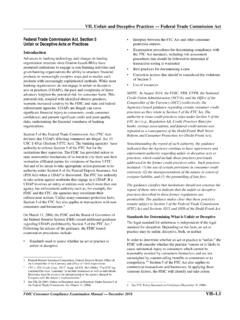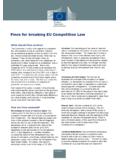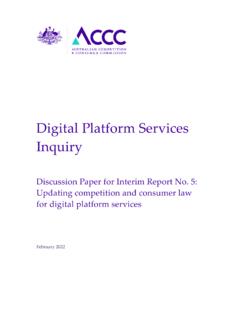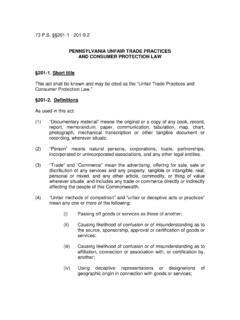Transcription of Characteristics of Monopolistic competition - MiamiOH.edu
1 1 Chapter 13 Monopolistic competition and Oligopoly Monopolistic competition . Definition. Output and price determination in SR and LR. Explain why advertising costs are high in a monopolistically competitive industry Oligolopoly Definition. Price and output determination game theory Cartels Anti-trust laws and regulation of marketsMonopolistic CompetitionCharacteristics of Monopolistic competition A large number of firms. limited market power (demand relatively elastic). Independent decision making Collusion impossible Each firm produces a differentiated product. compete on product quality, price, and marketing. Firms are free to enter and exit the industry. Economic profits driven to zero in long runMonopolistic CompetitionRed=4 largest. Green=5-8 Blue=9-20 The numbers are the Share in Monopolistic CompetitionOutput and Price in Monopolistic CompetitionThe Firm s Short-Run Output and Price DecisionHolding quality and marketing constant, profit maximization is achieved by choosing the price/quantity whereMR= MC2SR Output and Price in Monopolistic CompetitionWhat is profit maximizing price?
2 Quantity?What is the level of profit?What is socially efficient level of output?What is the deadweight loss?Output and Price in Monopolistic CompetitionLong Run: Zero Economic ProfitIn the long run, economic profit induces causes demand curve for existing firms to shift continues as long as firms in the industry earn an economic profit as long as (P > ATC).SR Output and Price in Monopolistic CompetitionGiven the short run equilibrium described, why does entry occur?As entry occurs, demand shifts leftward until profit equals zero. Output and Price in Monopolistic CompetitionDiagram at right shows long run equilibrium for a monopolistically competitive firm. economic profits? price mark-up (P vsMC)? excess capacity? socially efficient output? deadweight loss?3 Output and Price in Monopolistic CompetitionContrast to LR equilibrium for firms in perfect competition : Economic profits?
3 Excess capacity? Socially efficient? Deadweight loss?Output and Price in Monopolistic CompetitionIs Monopolistic competition EfficientBecause in Monopolistic competition P> MC, marginal benefit exceeds marginal cost ( deadweight loss ).But the markup of price above marginal cost arises from product competition brings the profitable and possibly efficient amount of variety to tends not to regulate monopolistically competitive Development and MarketingInnovation and Product DevelopmentTo keep earning an economic profit, a firm in Monopolistic competition must be in a state of continuous product product development allows a firm to gain a competitive edge, if only temporarily, before competitors imitate the Development and MarketingAdvertisingFirms in Monopolistic competition incur heavy advertising expenditures. Why?
4 How can advertising be profitable ? Changes in product demand versus changes in Development and MarketingAdvertising could increase product demand and also make it more elastic. Profits could rise or product demand becomes more elastic, (P-MC) markup could fall. Product Development and MarketingWith advertising, the firm produces 100 units of output at an average total cost of $ advertising expenditure shifts the average total cost curve upward, but the firm operates at a higher output and lower ATCthan it would without is Oligopoly?The distinguishing features of oligopoly are: Natural or legal barriers that prevent entry of new firms A small number of firms competeWhat is Oligopoly?Barriers to EntryEither natural or legal barriers to entry can create demand as drawn, there is a natural duopoly a market with two would answer change if demand increases?
5 5 What is Oligopoly?Small Number of FirmsBecause an oligopoly market has a small number of firms, the firms are interdependentand face a temptation to : With a small number of firms, each firm s profit depends on every firm s : A cartelis an illegal group of firms acting together to limit output, raise price, and increase in oligopoly face the temptation to form a cartel, but aside from being illegal, cartels often break is Oligopoly?Examples of OligopolyAn HHI that exceeds 1800 is generally regarded as an oligopoly by Department of HHI below 1800 is generally regarded as Monopolistic earlier caveats on HHI ( geographic boundaries, entry barriers)Two Traditional Oligopoly ModelsThe Kinked Demand Curve Model. SKIP Firm Oligopoly SKIP GamesGame theory a tool for studying strategic behavior, which is behavior that takes into account the expected behavior of others and the mutual recognition of Is a Game?
6 All games share four features: Rules Strategies Payoffs GamesThe Prisoners DilemmaEach prisoner is told that both are suspected of committing a more serious one of them confesses, he will get a 1-year sentence for cooperating while his accomplice get a 10-year sentence for both both confess to the more serious crime, each receives 3 years in jail for both neither confesses, each receives a 2-year sentence for the minor crime GamesNash equilibrium first proposed by John Nash -- if a player makes a rational choice in pursuit of his own best interest, he chooses the action that is best for him, given any action taken by the other s the Nash Equilibrium?What s the cooperative equilibrium?Oligopoly GamesAn Oligopoly Price-Fixing Game: pounds per year1000s of pounds per year400 Based on above diagram: What is competitive price, firm output, industry output, profit?
7 What is cartel ( collusive agreement ) price, output, profit? What is deadweight loss? Effect on consumer? Effect on producers? What is incentive to cheat ? How is this like prisoner s dilemma ? How do each of following affect ability to enforce cartel? Entry restrictions. Ability to monitor each GamesOligopoly GamesSuppose that the two firms enter into a collusive collusive agreement(or cartel agreement) is an agreement between two (or more) firms to restrict output, raise price, and increase agreements are illegal in the United States and are undertaken in GamesOther Oligopoly GamesAdvertising and R & D games are also prisoners R & D GameProcter & Gamble and Kimberley Clark play an R & D game in the market for disposable GamesHere is the payoff matrix for the Pampers Versus s the Nash Equilibrium? What s the collusive (cooperative) equilibrium?
8 8 Anti-trust formed merger guidelines in early 1980s. if post-merger HHI<1000==>industry competitive. if 1000<HHI<1800==>merger scrutinized (gray area). if HHI>1800==> merger likely to be challenged (red zone). in using concentration measures as indicators of competition for mergers. geographical scope of market product boundaries firms produce multiple products. Anti-trust policyLikelihood of collusion and DOJ anti-trust HHI is in a questionable area, other factors are considered. Barriers to entry Ability to monitor each other s behavior. Is the game repeated ? Anti-trust policyTheories of regulation. Public interest theory politicial process generates regulations designed to achieve socially efficient outcome. Capture theory regulations are designed to satisfy the demand of producers to maximize producer surplus.
9 Benefit producers (concentrated group) at expense of consumers (disperse group).Anti-trust policyEvidence on Deregulation of prices fell and volume increased. consumer surplus increased $ billion producer surplus increased $ billion. rapid change in structure of airline industry (hubs, excess capacity reduced, pricing changes, etc.)TRUCKING consumer surplus increased $ billion producer surplus decreased $ billion. truck driver s wages policyOTHER INDUSTRIES THAT HAVE BEEN DEREGULATED. natural gas long distance telephone cableDERGULATION IN PROCESS electric local telephoneAnti-trust policyAnti-trust Standard Oil Story: John D. Rockefeller owned standard oil. Able to extract discounts from the railroads for shipping During the 1870s, Standard Oil increased its capacity from 10 to 90 percent of the total. In 1882, the independent members of standard oil contributed shares to a central trust Allowed a central body to manage all firms.
10 The central body shut down some refineries, restricted production, and drove up oil policy1890: Sherman Act passed partly in response to the monopolization of the oil industry. Law prohibited combination, trust, or conspiracy to restrict interstate or international trade . Sherman Act used in 1911 to break up Standard Oil (created Exxon, Sohio, Chevron, etc.)Anti-trust policy 1914: Clayton Act. prohibited interlocking directorates & tying contracts 1914: Federal Trade Commission Act created FTC to prosecute unfair competition outlawed misleading policy 1936: Robinson-Patman Act (Chain store law) made quantity discounts illegal prevented stores from selling to public at unreasonably low prices. 1937: Miller-Tydings Act allowed Resale Price Maintenace if state approved. arguments against RPM (cartel enforcement) argument for RPM (high quality service) McTravel Apple computer








